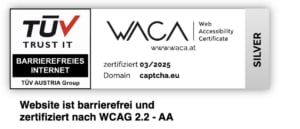
In today’s digital landscape, businesses face a critical challenge: protecting their websites from automated threats while ensuring a seamless experience for legitimate users. The evolution of CAPTCHA technology represents this ongoing balance between security and accessibility. As European businesses increasingly prioritize both robust protection and privacy compliance, understanding the landscape of invisible captcha solutions that are GDPR compliant becomes essential for making informed decisions.
Table of contents
- The Evolution of CAPTCHA Technology
- Understanding Invisible CAPTCHA: Functionality and Limitations
- The Next Generation: reCAPTCHA v3 and Its Implications
- Critical Factors in Selecting a CAPTCHA Solution
- The European Alternative: Privacy-First CAPTCHA Protection
- Integration and Implementation: Practical Considerations
- The Business Case for European CAPTCHA Solutions
- Case Study: European E-Commerce Implementation
- Future Directions in CAPTCHA Technology
- Conclusion: Balancing Security, Privacy, and User Experience
The Evolution of CAPTCHA Technology
The concept of CAPTCHA—Completely Automated Public Turing test to tell Computers and Humans Apart—has undergone significant transformation since its inception. Traditional CAPTCHAs required users to decipher distorted text, a method that relied on human cognitive abilities that automated systems struggled to replicate. This approach, while effective initially, created friction in the user journey and became increasingly vulnerable as artificial intelligence advanced.
Google’s acquisition of reCAPTCHA in 2009 marked a turning point in CAPTCHA development. The system evolved from text-based puzzles to more sophisticated verification methods, including the now-familiar “I’m not a robot” checkbox introduced in reCAPTCHA v2. This iteration utilized behavioral analysis, examining mouse movements and browsing patterns to distinguish humans from bots while reducing the cognitive load on users.
The development of Invisible reCAPTCHA represented another significant advancement, eliminating visible challenges entirely. By operating silently in the background, this technology analyzes user behavior without requiring direct interaction, creating a more streamlined experience. However, this seamless interaction comes with important considerations regarding data collection and privacy.
Understanding Invisible CAPTCHA: Functionality and Limitations
Invisible CAPTCHA operates through sophisticated behavioral analysis, monitoring aspects such as typing patterns, mouse movements, and browsing habits. This approach offers an undeniable advantage: legitimate users can navigate websites without confronting disruptive challenges or puzzles.
Despite these benefits, the invisible approach introduces significant privacy concerns. The extensive collection of behavioral data—often across multiple websites—raises questions about user consent and transparency. For European businesses operating under GDPR guidelines, these concerns carry particular weight, as regulations emphasize informed consent and data minimization.
Beyond privacy considerations, Invisible CAPTCHA faces practical challenges in its implementation. The system’s reliance on behavioral analysis can lead to false positives, particularly affecting users with disabilities who may utilize assistive technologies that create atypical interaction patterns. These users can find themselves incorrectly flagged as automated threats, creating barriers to accessibility that contradict core European values of inclusivity.
Moreover, sophisticated attack methods have evolved alongside CAPTCHA technology. “CAPTCHA farms,” services employing human workers to manually solve challenges, represent a growing vulnerability. These services effectively bridge the gap between human and automated interaction, allowing even less sophisticated bots to circumvent protection measures.
The Next Generation: reCAPTCHA v3 and Its Implications
Google’s response to the limitations of Invisible CAPTCHA came in the form of reCAPTCHA v3, which introduces a risk-based approach to security. Rather than requiring user interaction, this system continuously monitors behavior and assigns risk scores between 0 and 1, allowing website administrators to implement appropriate responses based on these assessments.
While this approach eliminates visible challenges entirely, it introduces new complexities for website administrators. The effective implementation of reCAPTCHA v3 requires constant fine-tuning of risk thresholds—set too high, legitimate users face unnecessary barriers; set too low, security vulnerabilities emerge. This ongoing maintenance demands significant resources and technical expertise.
The risk-scoring approach also introduces a transparency gap that can frustrate both users and administrators. Without clear feedback about how risk assessments are determined, users may not understand why they encounter challenges or restrictions. This lack of transparency can undermine trust and create friction in the customer journey, particularly for European audiences who increasingly value clarity in digital interactions.
Perhaps most concerning for European businesses is reCAPTCHA v3’s extensive data collection practices. The system gathers substantial behavioral information, potentially including browsing history across multiple websites, raising significant questions about GDPR compliance. These practices conflict with the growing European emphasis on data sovereignty and privacy-first approaches to digital security.
Critical Factors in Selecting a CAPTCHA Solution
For European businesses navigating these complex considerations, several key factors should guide the selection of a CAPTCHA solution:
User experience stands as a primary concern. The most effective CAPTCHA systems minimize friction while maintaining security, preserving the customer journey that businesses have carefully cultivated. Every additional second of delay or frustration in the verification process can impact conversion rates and customer satisfaction.
Security effectiveness remains the fundamental purpose of any CAPTCHA implementation. The solution must effectively distinguish between human users and increasingly sophisticated bots, adapting to evolving attack methodologies while maintaining protection against traditional threats.
Privacy compliance has become non-negotiable for European businesses. Any CAPTCHA solution must align with GDPR requirements and broader European values regarding data protection, ensuring that security doesn’t come at the cost of privacy.
Accessibility represents both an ethical imperative and a business consideration. European businesses must ensure that security measures don’t create barriers for users with disabilities, maintaining inclusive access to digital services while protecting against automated threats.
The European Alternative: Privacy-First CAPTCHA Protection
In response to these complex requirements, European-focused solutions like captcha.eu have emerged to address the specific needs of businesses operating under GDPR and aligned with European digital values. These solutions emphasize minimal data collection, processing all information within European borders while maintaining robust protection against automated threats.
The European approach to CAPTCHA technology prioritizes both security and user rights. Rather than gathering extensive behavioral data across multiple sites, privacy-focused solutions utilize targeted anomaly detection to identify suspicious patterns without compromising user privacy. This approach aligns perfectly with GDPR principles of data minimization and purpose limitation.
Accessibility represents another cornerstone of European CAPTCHA development. Solutions certified as barrier-free ensure that security measures don’t discriminate against users with disabilities, maintaining equal access while protecting against automated threats. This commitment to inclusivity reflects core European values while expanding potential audience reach for businesses.
Perhaps most importantly, European CAPTCHA solutions emphasize transparency in their operations. Users understand how and why verification occurs, building trust through clear communication rather than invisible background processes. This transparency extends to businesses implementing the solution, with straightforward integration processes and clearly communicated security protocols.
Integration and Implementation: Practical Considerations
The practical implementation of CAPTCHA technology represents a critical factor for businesses evaluating solutions. European-developed CAPTCHA systems typically offer seamless integration with popular content management systems including WordPress, TYPO3, NeosCMS, Joomla, and Magento, reducing technical barriers to adoption.
Beyond platform-specific integration, standardized APIs enable custom implementation across diverse digital environments. This flexibility allows businesses to maintain consistent security protocols across their digital ecosystem while adapting to specific technical requirements or user journeys.
The implementation process itself reflects European values of efficiency and clarity. Rather than requiring constant fine-tuning of risk thresholds, European solutions offer straightforward configuration options that balance security and accessibility. This approach reduces the ongoing maintenance burden for technical teams while maintaining effective protection.
Documentation and support represent another advantage of European CAPTCHA solutions. Clear, comprehensive guidance facilitates smooth implementation, while dedicated support from European-based teams ensures that any challenges receive prompt, culturally aligned assistance. This support structure proves particularly valuable for businesses without extensive technical resources.
The Business Case for European CAPTCHA Solutions
Beyond technical considerations, European businesses increasingly recognize the strategic advantages of implementing regionally developed CAPTCHA solutions. These advantages extend beyond compliance to create meaningful business benefits across multiple dimensions.
Customer trust represents perhaps the most significant advantage. European consumers increasingly consider data practices when choosing service providers, with privacy-focused approaches building stronger relationships. By implementing CAPTCHA solutions that respect user privacy, businesses demonstrate their commitment to ethical digital practices.
Operational efficiency improves through reduced false positives and straightforward implementation. European solutions designed with accessibility in mind generate fewer erroneous blocks of legitimate users, reducing customer service inquiries and improving conversion rates. The streamlined implementation process minimizes demands on technical resources, allowing teams to focus on core business priorities.
Compliance certainty provides peace of mind for business leaders navigating complex regulatory environments. European CAPTCHA solutions designed specifically for GDPR compliance reduce legal risks and simplify regulatory documentation. This compliance-by-design approach proves particularly valuable as data protection regulations continue to evolve.
Brand alignment with European values strengthens market positioning. Businesses can authentically emphasize their commitment to privacy and security when implementing European-developed solutions, reinforcing brand identity in increasingly privacy-conscious markets. This alignment resonates particularly strongly with European consumers who prioritize regional technological sovereignty.
Case Study: European E-Commerce Implementation
The practical impact of European CAPTCHA solutions becomes clear through real-world implementation scenarios. Consider a mid-sized European e-commerce business facing significant challenges from automated threats: credential stuffing attempts targeting customer accounts, bot-driven inventory hoarding during product launches, and form spam overwhelming customer service resources.
After implementing a European-developed CAPTCHA solution, the business experienced immediate improvements across multiple metrics. Bot traffic reduced by over 90%, improving site performance and reducing infrastructure costs. Customer account security strengthened without introducing friction to the login process. Product launches proceeded without inventory manipulation, creating fair access for legitimate customers.
Perhaps most significantly, the business maintained full GDPR compliance throughout this security enhancement. No additional data processing agreements were required, as all information remained within European borders under transparent processing practices. Customer feedback highlighted appreciation for the non-intrusive verification process, reinforcing the brand’s reputation for respecting user experience and privacy.
Future Directions in CAPTCHA Technology
As we look toward the future of digital security, several emerging trends will shape the evolution of CAPTCHA technology. European developers continue leading innovation in privacy-preserving verification methods, exploring approaches that maintain robust security without compromising user rights.
Passive biometric analysis represents one promising direction, utilizing patterns like keystroke dynamics or mouse movements in privacy-preserving ways. Unlike traditional biometrics that collect identifying information, these approaches analyze behavior patterns without storing personal data, maintaining anonymity while effectively distinguishing humans from bots.
Contextual analysis offers another innovative approach, examining the relevance of user actions within specific digital environments rather than tracking behavior across multiple sites. This focused analysis aligns perfectly with GDPR principles of purpose limitation while maintaining effective threat detection.
AI-resistant design principles guide European CAPTCHA development as artificial intelligence continues advancing. Rather than engaging in an endless arms race with increasingly sophisticated bots, European solutions focus on verification methods that leverage fundamental differences between human and automated interaction, creating sustainable security models.
Conclusion: Balancing Security, Privacy, and User Experience
The evolution of CAPTCHA technology reflects broader tensions in digital security: the balance between protection and privacy, between security and accessibility, between technological sophistication and practical implementation. European businesses navigating these tensions increasingly recognize the advantages of regionally developed solutions that reflect shared values and regulatory frameworks.
As automated threats continue evolving in sophistication, effective CAPTCHA protection remains essential for maintaining digital security. However, this protection need not come at the expense of user privacy or experience. European solutions demonstrate that robust security can coexist with privacy preservation and accessibility, creating a model that respects both business needs and user rights.
By implementing European-developed CAPTCHA solutions, businesses protect their digital assets while aligning with regional values and regulations. This alignment creates advantages beyond security alone—building customer trust, simplifying compliance, and reinforcing brand identity as privacy-conscious and user-focused.
The future of digital interaction will continue requiring verification mechanisms that distinguish between human and automated users. European innovation in this space ensures that these mechanisms will evolve in ways that respect fundamental rights while maintaining effective protection, creating secure digital environments where legitimate users engage freely while automated threats remain effectively managed.
For businesses committed to both security and European values, privacy-focused CAPTCHA solutions represent not just a technical implementation but a strategic alignment with the future of digital interaction—secure, private, and accessible for all legitimate users.




